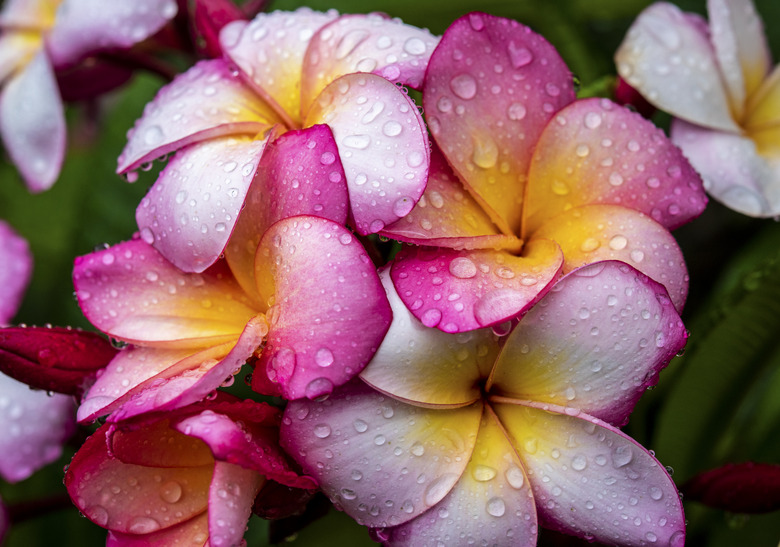How To Make A Plumeria Plant Flower
We may receive a commission on purchases made from links.
The fragrant, tropical blossoms of the plumeria (Plumeria spp.), also known as frangipani, fill the garden or sunroom with their sweet scent. To make a plumeria plant flower, it needs four basic elements: water, fertilizer, warmth and plenty of light. Hardy in U.S. Department of Agriculture plant hardiness zones 10 through 12, this native of Central and South America, Mexico and the Caribbean cannot tolerate freezing temperatures.
Water: Don't Overwater
Water: Don't Overwater
Plant your plumeria on a well-draining, organically rich potting soil. The ideal pH level is slightly acidic at 6.4 to 6.8. Water through the growing season when the soil is dry to a depth of 1 to 2 inches. Add water until it drains from the bottom of the container and then empty the saucer so the plumeria doesn't sit in water.
Mist plumeria regularly to keep the humidity high around the plant. Place the pot on a tray filled with pebbles and water or group it with other houseplants to increase humidity. A cool-mist humidifier can also add humidity if your air is exceptionally dry. Avoid placing your plumeria near heating or air-conditioning ducts.
In winter, ease off on watering. If your plumeria loses its leaves and goes dormant, water lightly every two weeks to prevent the soil from going bone dry. Resume normal watering when new growth appears in spring.
Fertilizer: Feed With Phosphorus
Fertilizer: Feed With Phosphorus
During the growing season when the plumeria is producing new foliage and is flowering, alternate fertilizing with a balanced 20-20-20 fertilizer and a high-phosphorus 10-30-10 fertilizer. When using liquid fertilizers, apply every two to three weeks. If you prefer a slow-release fertilizer, apply every two to three months according to the instructions. Always water thoroughly after fertilizing.
Alternatively, use a plumeria fertilizer or "blossom booster" fertilizer with a phosphorus level of 50 or above to make your plumeria plant flower. Phosphorus supports bud formation and flowers. Avoid high-nitrogen fertilizers, which encourage foliage growth at the expense of flowers.
Stop fertilizing in late summer or early fall. The plumeria's growth will slow, and it may drop its leaves and go dormant when winter arrives. Begin fertilizing again in spring when new growth appears.
Temperature: Keep Your Plumeria Warm
Temperature: Keep Your Plumeria Warm
Inside or out in the garden, your plumeria needs warmth to thrive. When temperatures drop below 50 to 55 degrees Fahrenheit, the plant will go dormant. As temperatures warm into the 70s, your plumeria will revive and produce new leaves. Keep your plumeria in a warm location inside or a sunny, sheltered location outside.
Light: Make a Plumeria Plant Flower
Light: Make a Plumeria Plant Flower
Plumeria flower bud growth is stimulated by rising temperatures and longer daylight hours. A warm sunroom, greenhouse or bright, south-facing window provides the light your plumeria needs to flower. Add a grow light or fluorescent fixture over the plant if it is not producing flowers; generally, too little light is a significant factor in failure to blossom.
You can take your plumeria outside for a summer vacation. After all chance of frost has passed, acclimate the plumeria by putting it outside in dappled or part shade and then slowly move it into a full-sun location. Plumeria plants bloom best when they receive at least six hours of sunlight daily. Take it indoors when the days grow shorter and cool below 65 to 70 degrees.
Propagation: Seedlings and Cuttings
Propagation: Seedlings and Cuttings
Start new plumeria plants by sowing the winged seeds in sterile seed-starting mix. Keep the medium moist while the seeds germinate in three to 14 days. Mist regularly as the seedlings grow.
The seedlings will not be exactly like the parent plant. In addition, seedlings require three to five years of growth before they begin producing flowers. For an exact replica of your favorite plumeria and faster flowering, propagate with cuttings .
Take a 12- to 15-inch cutting of a mature branch with gray bark. Remove all the leaves and set the cutting aside for three to five days. Wet the end of the cutting, swirl it in rooting compound and insert it 3 to 5 inches deep in moist potting soil. Place it in bright shade and do not water until new leaves appear in five to six weeks.
Safety and the Plumeria
Safety and the Plumeria
Before working with plumeria, whether pruning, taking cuttings or repotting, put on gloves, long sleeves and safety goggles. The milky sap can irritate the eyes, and sensitive individuals may have a skin reaction. In addition, sterilize your cutting tool by dipping the blades in rubbing alcohol. You can also use a rag dipped in the sterilizing solution to wipe your pruners between cuts. Keep all parts of the plumeria, fertilizers, cutting tools and sterilizing solutions out of the reach of children and pets.
